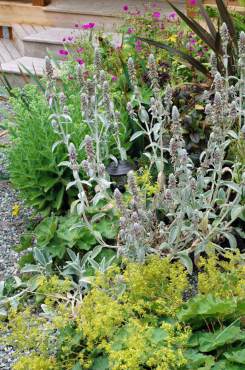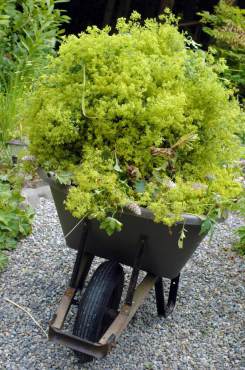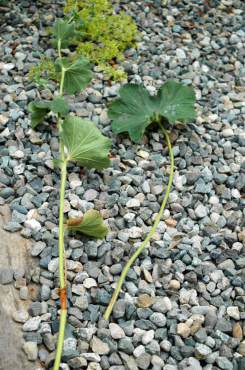
As the days of summer heat up, the last thing we want to do is work hard in the garden. This is the time to enjoy it, play in the sprinklers and hang out with friends.
Here are a few tips to help you reach this nirvana.
Mulch
Hopefully you took some time this spring, before the perennials flushed out, to weed and cover your soil with a good mulch. Mulch not only helps to conserve moisture and improve your soil’s tilth as it decomposes and feeds the soil organisms, it can greatly reduce the number of weeds in your beds.
My favorite topdressing is arborist chips, which includes chopped wood, bark and leaves. The chips harbor no weed seeds, contain a balance of green and brown material, are chunky enough to allow water to penetrate into the soil, and break down slowly.
If they are used as topdressing and not worked into the soil, their decomposition will not use up excessive nitrogen. And best of all, they can be obtained for free from an arborist, or for a small fee from some of our landscape material suppliers.
If your soil needs a nutrient boost, lay down a 2-inch layer of good compost first, and then cover it with a 2- to 4-inch layer of arborist chips. Be careful not to smother your plants, and do not pile up mulch against the trunk of shrubs and tree trunks.

Watering
I am a firm believer in drip irrigation beneath a layer of mulch. This approach saves an amazing amount of water (some claims are as high as 90 percent); delivers moisture where it is needed, directly in the root zone; and eliminates watering pathways, thus eliminating weed growth.
I still use soaker hoses where I need a quick solution and do not need to cover more than a 100 feet of linear distance. I remove the blue disk that is sold in the hose to control water pressure and use battery-operated timers. I run the hose either parallel to the slope’s contours or downhill, but never uphill. Soaker hoses do not deliver the same amount of water along the whole hose, and these techniques deliver enough water to the end of my soaker hoses.
A better system, though more time-consuming and more expensive to install, is a drip system that has pressure-compensated drip emitters spaced at regular intervals along a solid hose. Netafim and Rainbird are two reputable brands. Both of these systems will deliver the same amount of water along the length of the hose, as long as the runs do not exceed the recommendations.
Attached to a timer, these systems do their work automatically, quietly and without getting water on the foliage of plants that could potentially cause fungal diseases.
Weeding and Deadheading
One thing you can’t go to sleep on if you want to avoid a billion seeds from settling in your beds is getting the weeds and spent flowers out before they go to seed. Never walk by a weed in flower without yanking it out; before you know it, it will have gone to seed and spread its progeny all over your garden!

Mow the lawn before the dandelions have a chance to release their parachutes, clip the lady’s mantle before the pretty chartreuse flowers begin to turn slightly brown and so on. They are deceiving you by looking pretty and innocent while ripening their seed!
It is hard to cut flowers that still look good, but sometimes you have to be tough. Euphorbia, lady’s mantle, foxglove, lamb’s ears, hardy geraniums and poppies are all great at lulling us into complacency, rewarding us with flowers while spreading their seeds in secrecy.
I don’t know about you, but I am notorious for leaving piles of weeds and my prunings laying around. The plants know of this lazy tendency among many gardeners and take advantage by continuing to ripen while they lie there, quickly turning from flowers to seed even after they were pulled.
Help yourself out by having containers strategically placed around the garden or always keeping your wheelbarrow close at hand to receive your piles. Use a bungee cord to hold an immense amount of plant material on your wheelbarrow.
Never put these on your compost pile that you plan to use in your garden or they will sprout again, unless your compost gets hot enough to kill seeds.
Make quick work of deadheading by studying the stems of the plants you are working on. Often, the flower stems are quite different from the stems of leaves, and learning to tell the difference will help you cut them quickly at the base of the plant. This lady’s mantle in the photo, for example, has brown segments on the flower stems, while the leaf stems are smooth and green.
I hope these tips will help you kick back and enjoy the summer!



























